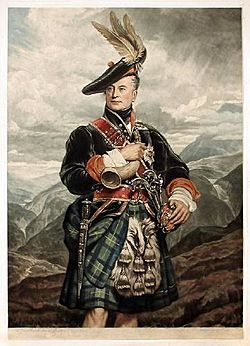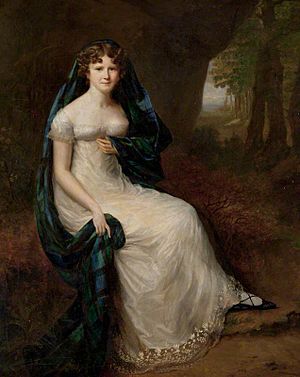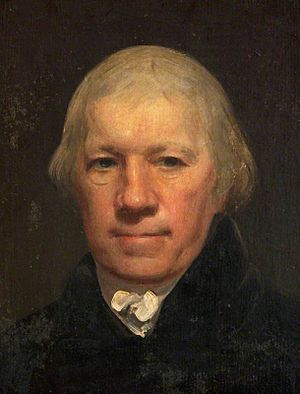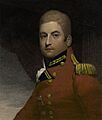George Gordon, 5th Duke of Gordon facts for kids
Quick facts for kids
The Duke of Gordon
|
|
|---|---|

The Duke depicted in highland dress by George Sanders, now in Goodwood House
|
|
| Born | George Gordon 2 February 1770 Edinburgh, Kingdom of Great Britain |
| Died | 28 May 1836 (aged 66) Belgrave Square, London, United Kingdom of Great Britain and Ireland |
| Known for | Nobleman, soldier, and politician |
| Nationality | British |
| Wars and battles | French Revolutionary Wars |
| Offices | Grand Master of the Grand Lodge of Scotland (1792 to 1794) Member of Parliament for Eye (1806 to 1807) Keeper of the Great Seal of Scotland (1828 to 1830) Privy Counsellor (1830 to death) |
| Spouse(s) | Elizabeth Brodie |
| Issue | Georgiana McCrae |
| Parents | Alexander Gordon, 4th Duke of Gordon Jane Maxwell |
|
|
|
General George Duncan Gordon, 5th Duke of Gordon (born February 2, 1770 – died May 28, 1836) was an important Scottish nobleman, soldier, and politician. He was known as the Marquess of Huntly until 1827. He was the last person in his direct family line to hold the title of Duke of Gordon.
Contents
A Young Soldier's Life
George was born in Edinburgh, Scotland, on February 2, 1770. He was the oldest son of Alexander Gordon, 4th Duke of Gordon and his wife, Jane Gordon, Duchess of Gordon. George went to school at Eton College, a famous school in England.
He chose to become a soldier and worked his way up to the rank of general. As the Marquess of Huntly, he served with the guards in a region called Flanders from 1793 to 1794.
Leading the Gordon Highlanders
In May 1796, George became the Colonel in Chief of a new army group. This group was called the 92nd Highlanders, often known as the "Gordon Highlanders." They were named in honor of his family.
- In 1798, he served with this group in Ireland as a Brigadier General.
- He then went with them to Holland in 1799.
- On October 2, 1799, he was hurt during a battle in Holland.
In 1806, he left the 92nd Highlanders. He then became the Colonel in Chief of the 42nd Regiment of Foot, also known as the "Black Watch." Later, from 1820, he commanded the 1st (Royal Foot) regiment. He also led a group of soldiers in the Walcheren Expedition in 1809.
Political Roles and Public Service
George was also involved in politics and public life.
- He was a freemason and led the Grand Lodge of Scotland from 1792 to 1794.
- He was a Member of Parliament for a place called Eye from 1806 to 1807.
- In 1807, he joined the House of Lords, which is part of the British Parliament.
- He became a Privy Counsellor in 1830. This is a special advisor to the King or Queen.
- From 1828 to 1830, he was the Keeper of the Great Seal of Scotland. His father had held this same job before him.
- From 1834 to 1836, he was the Governor of Edinburgh Castle.
He left the 1st regiment in 1834 and joined the Scots Fusilier Guards. He passed away on May 28, 1836.
His Marriage and Family Life


George married Elizabeth Brodie in Bath on December 11, 1813. She was 24 years younger than him. Elizabeth was the daughter of Alexander Brodie, a wealthy man from Scotland.
One writer described Elizabeth Brodie as a good and rich person. She helped George with his money problems. Her father gave her a large sum of money when she married, and even more when he died. She was known for being sensible and good at managing money.
Before his marriage, George often had money troubles. People said he was "overwhelmed with debts." His marriage helped with some of these problems, but they did not have any children together who could inherit his titles.
Important Positions and Beliefs
Like his father, George held many important positions that were usually given to the Gordon family. These included:
- Lord Lieutenant of Aberdeenshire
- Chancellor of Marischal College in Aberdeen
- Lord High Constable of Scotland
He held the Lord High Constable position for the crowning ceremony of King George IV in 1820.
When he became Duke, he was known for having very strong traditional views. He was against the Great Reform Bill, which aimed to change how people voted. He was one of only 22 people who voted against this bill in the House of Lords in 1832.
During this time, his wife, Elizabeth, worked for Queen Adelaide. The Queen even gave Elizabeth her coronation robe, which can now be seen at Brodie Castle.
An American journalist named Nathaniel Parker Willis visited Gordon Castle when the Duke was older. He described the grand life there, with many servants, ladies riding horses, and lots of deer and pheasants. He was amazed by the wealth and tradition of the family.
His Legacy
The Duke passed away in London on May 28, 1836, when he was 66 years old. Because he had no direct children, the Dukedom of Gordon ended. However, another title, the Marquessate of Huntly, went to a distant cousin. The Gordon family's lands went to his nephew, Charles Gordon-Lennox, 5th Duke of Richmond. The Duchess left the family's movable belongings to the Brodies of Brodie.
Elizabeth Brodie, the last Duchess of Gordon, moved to Huntly Castle Lodge after her husband died. She became very religious and lived there until her death on January 31, 1864. With her passing, the last connection to the original Dukedom of Gordon also ended.
The Duke and Duchess of Gordon helped build the Gordon Chapel in Fochabers. There is a special memorial tablet there for the 5th and last Duke.
The Duke had three children outside of his marriage: Charles Gordon, Susan Sordet, and Georgiana McCrae.
Images for kids







